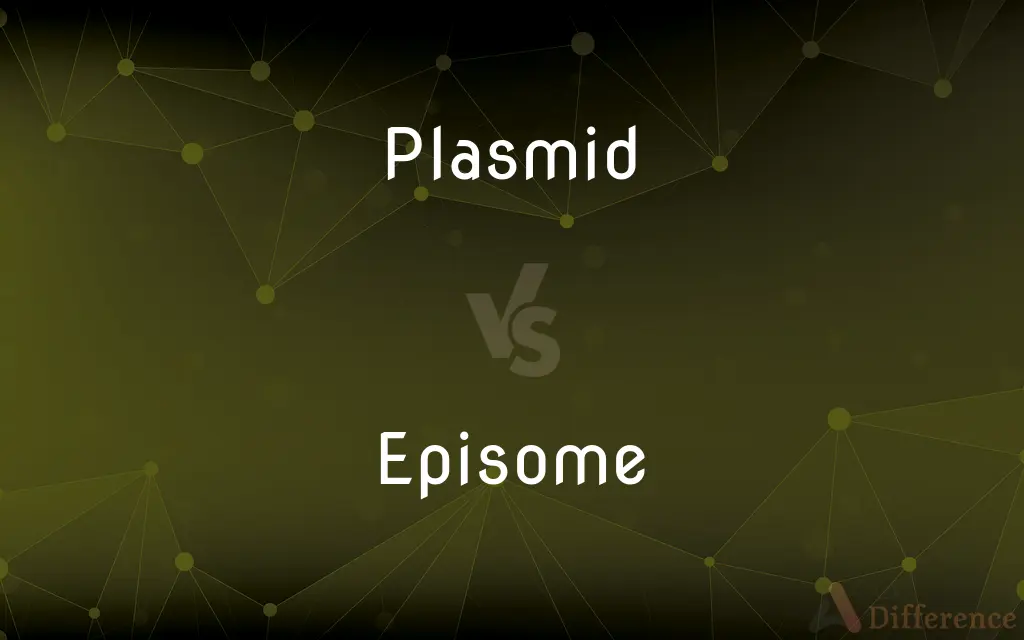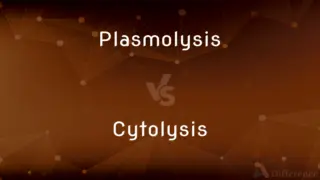Plasmid vs. Episome — What's the Difference?
By Urooj Arif & Fiza Rafique — Updated on March 21, 2024
Plasmids are small, circular DNA molecules found in bacteria, separate from chromosomal DNA, used in gene cloning. Episomes are DNA elements that can exist independently or integrate into a chromosome.

Difference Between Plasmid and Episome
Table of Contents
ADVERTISEMENT
Key Differences
Plasmids are extra-chromosomal DNA molecules in bacteria, typically circular and double-stranded, playing a crucial role in gene cloning and genetic engineering by carrying foreign genes. On the other hand, episomes, a broader category of DNA elements, can replicate independently in the cytoplasm or integrate into the host's chromosome, affecting gene expression and regulation.
Plasmids are naturally occurring in bacteria and some yeasts, providing benefits like antibiotic resistance or metabolic advantages under certain conditions. Episomes, while similar in function, have the unique ability to integrate into the host genome, which can include both prokaryotic and eukaryotic organisms, offering a mechanism for genetic variation and evolution.
The size of plasmids can vary, but they are generally smaller than episomes, making them more manageable for use in laboratory genetic manipulation. Whereas episomes, due to their ability to integrate into chromosomes, can be larger and play more complex roles in genetic regulation and expression.
Plasmids are used extensively in biotechnology and genetic engineering as vectors for gene cloning, gene expression, or the production of recombinant proteins because of their ease of manipulation and stable inheritance. In contrast, episomes are studied for their role in gene regulation, the development of certain diseases, and their potential use in gene therapy due to their ability to integrate into host genomes.
In terms of genetic transfer, plasmids can be transferred between cells through processes like conjugation, transformation, or transduction, promoting genetic diversity among bacterial populations. Episomes, with their dual nature, can also be transferred between cells but have the added capability of altering host genetic information by integrating into the host's chromosome, which can have significant evolutionary implications.
ADVERTISEMENT
Comparison Chart
Definition
Small, circular DNA molecules in bacteria, used for gene cloning.
DNA elements that can exist independently or integrate into chromosomes.
Natural Occurrence
Bacteria, some yeasts
Bacteria, some eukaryotes
Function
Carry foreign genes, confer antibiotic resistance, etc.
Affect gene expression and regulation, genetic variation.
Genetic Engineering
Extensively used as vectors in gene cloning and genetic engineering.
Studied for gene regulation, disease development, and gene therapy.
Size and Complexity
Generally smaller and less complex
Can be larger, more complex due to integration capability
Genetic Transfer
Through conjugation, transformation, transduction
Also through these processes, but with integration into the host genome
Role in Genetic Variation
Promote genetic diversity among bacteria
Alter host genetic information, evolutionary implications
Compare with Definitions
Plasmid
Vectors for gene cloning, gene expression.
Plasmids are fundamental tools in the production of recombinant proteins.
Episome
DNA elements that replicate independently or integrate into a chromosome.
The episome integrates into the host's chromosome, altering gene expression.
Plasmid
Used in gene cloning and genetic engineering.
The plasmid was engineered to include a gene of interest.
Episome
Studied for their role in gene regulation and evolution.
The study focused on episomal integration patterns and their effects.
Plasmid
Small, circular DNA molecules independent of chromosomal DNA in bacteria.
Scientists use plasmids as vectors for introducing new genes into bacteria.
Episome
Found in both prokaryotic and eukaryotic organisms.
The episome was identified in bacterial cells and certain eukaryotic cells.
Plasmid
Common in bacteria and some yeasts.
The bacteria harbored a plasmid conferring antibiotic resistance.
Episome
Potential use in gene therapy due to integration capability.
Scientists explore episomes for targeted gene therapy applications.
Plasmid
Crucial for studying gene function and expression.
Researchers inserted the gene into a plasmid to study its expression.
Episome
Can exist extrachromosomally or as part of the chromosome.
Episomes play a role in both normal cellular processes and disease development.
Plasmid
A plasmid is a small, extrachromosomal DNA molecule within a cell that is physically separated from chromosomal DNA and can replicate independently. They are most commonly found as small circular, double-stranded DNA molecules in bacteria; however, plasmids are sometimes present in archaea and eukaryotic organisms.
Episome
A segment of DNA in certain cells, especially bacterial cells, that can exist either autonomously in the cytoplasm or as part of a chromosome.
Plasmid
A circular, double-stranded unit of DNA that replicates within a cell independently of the chromosomal DNA. Plasmids are most often found in bacteria and are used in recombinant DNA research to transfer genes between cells.
Episome
(cytology) A segment of DNA that can exist and replicate either autonomously in the cytoplasm or as part of a chromosome, mainly found in bacteria
Plasmid
(cytology) A loop of double-stranded DNA that is separate from and replicates independently of the chromosomes, most commonly found in bacteria, but also in archaeans and eukaryotic cells, and used in genetic engineering as a vector for gene transfer.
Episome
Synonym of epitheca
Plasmid
A piece of DNA, usually circular, functioning as part of the genetic material of a cell, not integrated with the chromosome and replicating independently of the chromosome, but transferred, like the chromosome, to subsequent generations of daughter cells. In bacteria, plasmids often carry the genes for antibiotic resistance; they are exploited in genetic engineering as the vehicles for introduction of extraneous DNA into cells, to alter the genetic makeup of the cell. The cells thus altered may produce desirable proteins which are extracted and used; in the case of genetically altered plant cells, the altered cells may grow into complete plants with changed properties, as for example, increased resistance to disease.
Plasmid
A small cellular inclusion consisting of a ring of DNA that is not in a chromosome but is capable of autonomous replication
Common Curiosities
What is an episome?
An episome is a DNA element that can exist independently of the host's chromosome or integrate into it.
How do plasmids and episomes differ in genetic engineering?
Plasmids are widely used as vectors in genetic engineering for their ease of manipulation, whereas episomes are studied for gene regulation and potential in gene therapy.
Can episomes integrate into the host genome?
Yes, episomes have the unique ability to integrate into the host's chromosome, affecting gene expression and regulation.
What makes plasmids important tools in biotechnology?
Their small size and the ability to carry foreign genes make plasmids indispensable for gene cloning and the production of recombinant proteins.
What is a plasmid?
A plasmid is a small, circular DNA molecule found in bacteria, separate from chromosomal DNA, used in gene cloning.
What methods allow plasmids to be transferred between cells?
Plasmids can be transferred through conjugation, transformation, or transduction.
Why are episomes important for studying diseases?
Their role in gene regulation and potential integration into the genome makes them valuable for understanding the genetic basis of diseases.
What applications do plasmids have outside of genetic engineering?
Besides genetic engineering, plasmids are used in research to study gene function and regulation.
Are episomes found in eukaryotic cells?
Yes, episomes can occur in both prokaryotic and eukaryotic cells, including humans.
How do episomes affect genetic variation?
By integrating into the host genome, episomes can introduce genetic changes, contributing to genetic variation and evolution.
What role do plasmids play in genetic diversity?
Plasmids promote genetic diversity among bacterial populations by spreading new genes.
How do episomes differ from plasmids in terms of complexity?
Episomes can be larger and more complex due to their ability to integrate into chromosomes, affecting gene regulation.
How do plasmids contribute to antibiotic resistance?
Plasmids can carry genes that confer antibiotic resistance to bacteria, spreading these traits through populations.
How do episomes contribute to evolutionary processes?
By altering host genetic information through integration, episomes contribute to evolutionary changes and adaptation.
Can episomes be used in gene therapy?
Yes, their capability to integrate into host genomes makes them potential vectors for gene therapy.
Share Your Discovery

Previous Comparison
Plasmolysis vs. Cytolysis
Next Comparison
Dare vs. DearAuthor Spotlight
Written by
Urooj ArifUrooj is a skilled content writer at Ask Difference, known for her exceptional ability to simplify complex topics into engaging and informative content. With a passion for research and a flair for clear, concise writing, she consistently delivers articles that resonate with our diverse audience.
Co-written by
Fiza RafiqueFiza Rafique is a skilled content writer at AskDifference.com, where she meticulously refines and enhances written pieces. Drawing from her vast editorial expertise, Fiza ensures clarity, accuracy, and precision in every article. Passionate about language, she continually seeks to elevate the quality of content for readers worldwide.














































